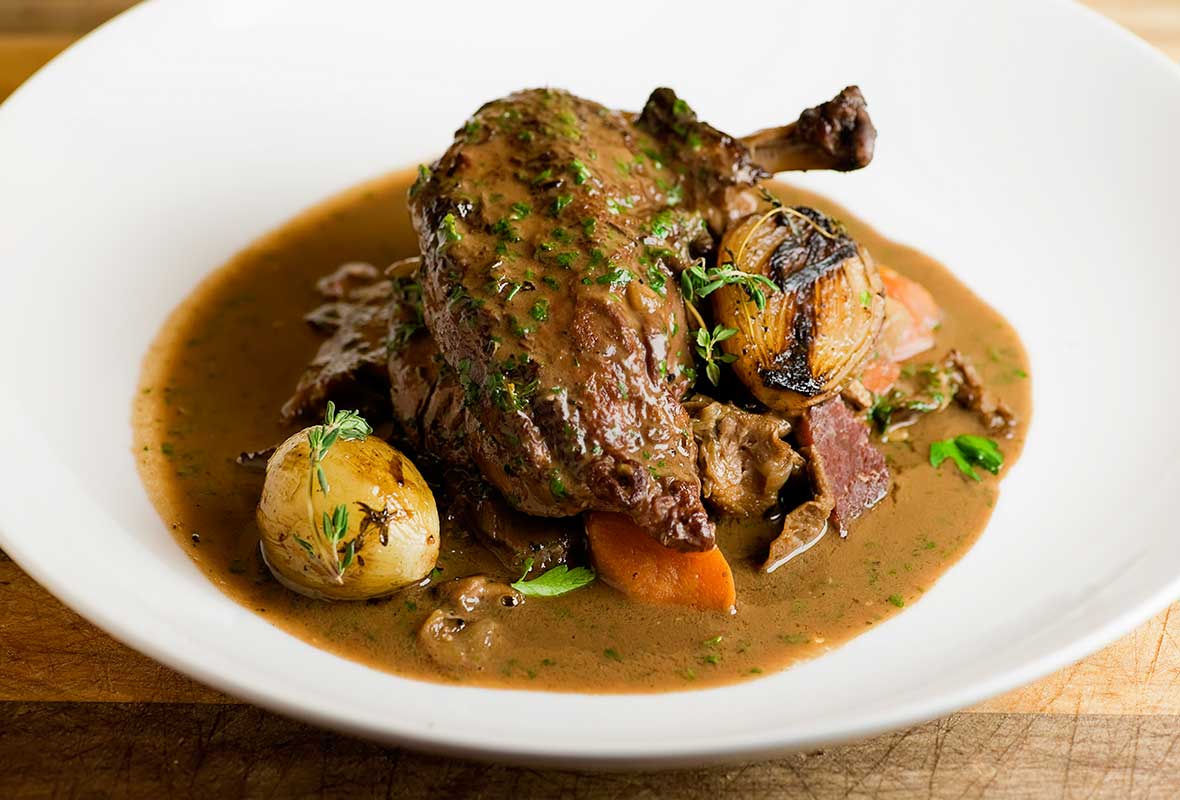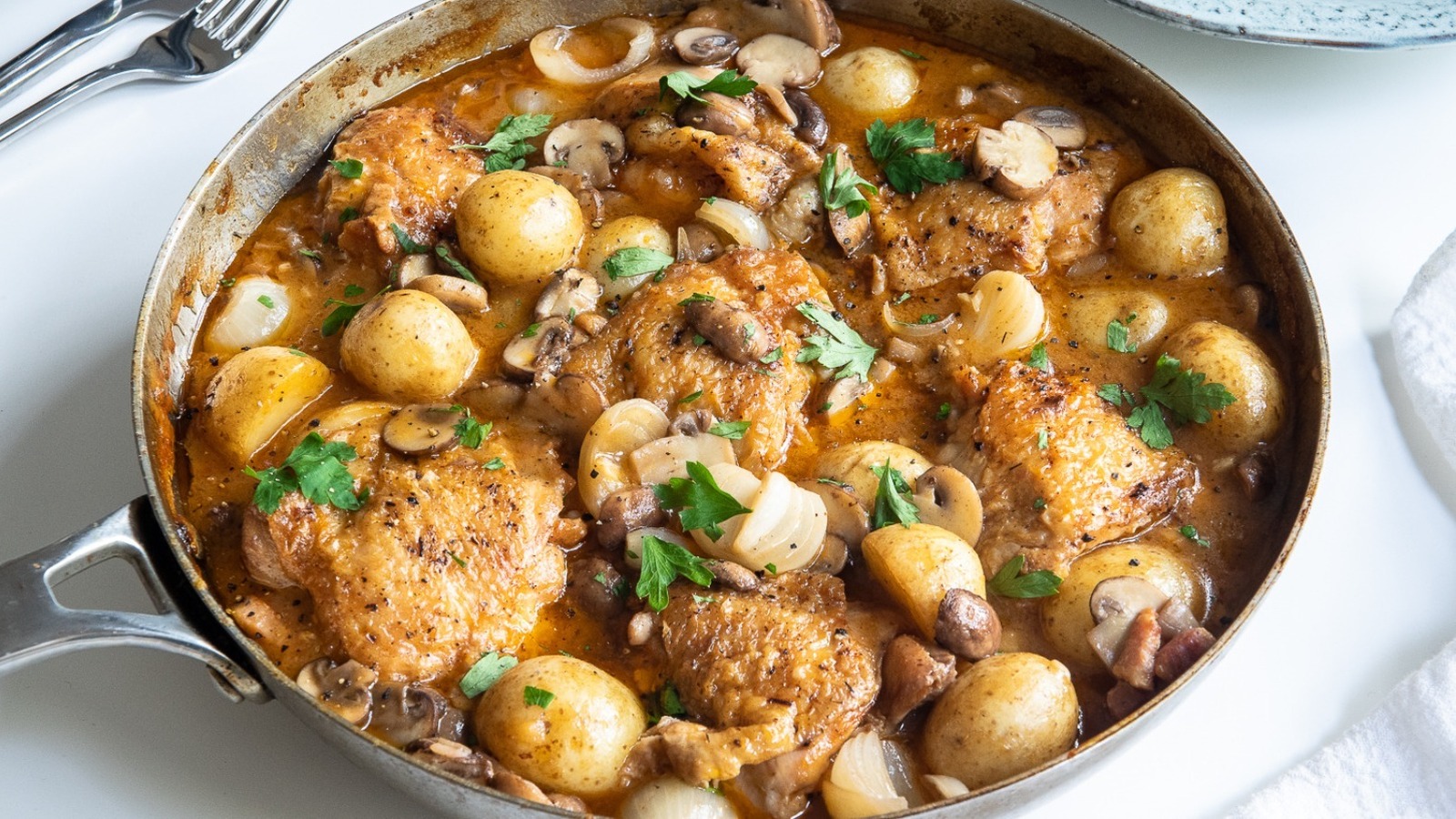Step into the world of Julia Child, the renowned culinary icon who brought French cooking to American kitchens. Her Coq au Vin recipe stands as a testament to her passion for food and her ability to simplify complex techniques. Join us as we delve into the secrets behind this classic dish, exploring its ingredients, preparation, and the culinary legacy it has left behind.
From the vibrant flavors of Burgundy wine to the tender fall-off-the-bone chicken, Coq au Vin embodies the essence of French cuisine. Julia Child’s unique approach to this dish has inspired generations of home cooks, and we will uncover the secrets behind her techniques, ensuring you can recreate this culinary masterpiece in your own kitchen.
Julia Child’s Coq au Vin
Julia Child’s Coq au Vin is a classic French dish that is made with chicken braised in red wine, bacon, mushrooms, and vegetables. The dish is typically served with mashed potatoes or noodles.
Child’s recipe for Coq au Vin is unique in that she uses a combination of techniques to create a flavorful and tender dish. She first marinates the chicken in a mixture of red wine, herbs, and spices. This helps to tenderize the chicken and infuse it with flavor.
She then browns the chicken in a skillet before braising it in a mixture of red wine, chicken stock, and vegetables. This creates a rich and flavorful sauce that coats the chicken.
Her Unique Techniques
Some of Child’s unique techniques for preparing Coq au Vin include:
- Marinating the chicken in red wine, herbs, and spices
- Browning the chicken in a skillet before braising it
- Using a combination of red wine, chicken stock, and vegetables to create the braising liquid
- Cooking the dish for several hours, or even overnight, to allow the flavors to develop
These techniques result in a Coq au Vin that is flavorful, tender, and juicy. It is a dish that is sure to impress your guests.
Ingredients and Preparation

Julia Child’s Coq au Vin is a classic French dish that combines the flavors of chicken, wine, and vegetables. The ingredients are simple, but the preparation is time-consuming. However, the end result is a delicious and hearty meal that is perfect for a special occasion.
The first step in making coq au vin is to marinate the chicken. The chicken is placed in a large bowl or container and covered with a mixture of red wine, brandy, garlic, thyme, bay leaves, and salt and pepper.
The chicken is then refrigerated for at least 12 hours, or up to 24 hours.
Once the chicken has marinated, it is removed from the marinade and patted dry. The chicken is then browned in a large skillet over medium heat. Once the chicken is browned, it is removed from the skillet and set aside.
The vegetables are then added to the skillet and cooked until they are softened. The vegetables that are typically used in coq au vin include onions, carrots, celery, and mushrooms. Once the vegetables are softened, the chicken is added back to the skillet and the marinade is poured over the top.
The coq au vin is then simmered over low heat for at least 2 hours, or until the chicken is cooked through.
Variations and Substitutions
There are many different variations of coq au vin. Some recipes call for using white wine instead of red wine. Others add additional ingredients to the marinade, such as bacon or tomatoes. You can also substitute different vegetables in the dish, such as green beans or potatoes.
Cooking Techniques
Julia Child’s Coq au Vin employs a combination of classic French cooking techniques to achieve its rich and complex flavors.
Browning the Chicken
Browning the chicken creates a flavorful crust that adds depth to the dish. The Maillard reaction, a chemical reaction between amino acids and sugars, occurs during browning, producing compounds that enhance the taste and aroma of the chicken.
Deglazing the Pan
After browning the chicken, the pan is deglazed with white wine. This process involves pouring the wine into the hot pan and scraping up the browned bits, releasing their concentrated flavors. The wine also helps to dissolve any remaining fat or residue, creating a flavorful sauce base.
Reducing the Wine
The deglazed wine is then reduced by simmering it until it thickens and intensifies in flavor. This process concentrates the wine’s aromas and flavors, creating a rich and complex sauce that complements the chicken.
Slow-Cooking
The chicken is then braised in the reduced wine sauce for several hours, allowing the flavors to meld and develop. The low and slow cooking process tenderizes the chicken and infuses it with the flavors of the wine, vegetables, and herbs.
Development of Flavors
The combination of browning, deglazing, reducing, and slow-cooking creates a symphony of flavors in Coq au Vin. Each technique contributes to the dish’s rich, complex, and satisfying taste.
Variations and Adaptations
Julia Child’s Coq au Vin recipe is a classic, but there are many ways to vary it to suit your own taste. Here are a few ideas:
Poultry and Vegetables
You can use different types of poultry for your Coq au Vin, such as chicken, duck, or turkey. You can also add different vegetables to the pot, such as carrots, celery, onions, leeks, or mushrooms.
Modern Adaptations
There are many modern adaptations of Coq au Vin that can make it more accessible to home cooks. For example, you can use a slow cooker to cook the dish, which will make it more tender and flavorful. You can also use pre-cut vegetables to save time.
Vegetarian and Gluten-Free Versions
If you’re vegetarian, you can make a vegetarian version of Coq au Vin using tofu or tempeh. You can also make a gluten-free version of the dish by using gluten-free flour.
Experimentation
The best way to find your favorite Coq au Vin recipe is to experiment with different ingredients and flavors. Don’t be afraid to try different combinations of poultry, vegetables, and seasonings until you find the perfect dish for you.
Presentation and Serving Suggestions
Julia Child’s Coq au Vin is a visually stunning and flavorful dish that deserves an elegant presentation. Here are some tips for showcasing this culinary masterpiece:
Before serving, arrange the chicken pieces on a large serving platter or individual plates. Pour the rich sauce over the chicken, ensuring it evenly coats each piece. Garnish the dish with fresh parsley or chives for a vibrant pop of color and freshness.
Accompaniments
Coq au Vin pairs well with a variety of accompaniments. Serve it alongside mashed potatoes, rice, or egg noodles to soak up the delicious sauce. A side of roasted vegetables, such as carrots, parsnips, or green beans, adds a healthy and colorful touch to the meal.
Carving and Serving
To carve the chicken, use a sharp knife to carefully remove the legs, thighs, wings, and breast meat. Arrange the pieces on the serving platter or plates. Serve immediately, while the dish is still hot and the sauce is at its peak flavor.
Culinary Significance and Legacy
Julia Child’s Coq au Vin holds a significant place in culinary history, leaving an indelible mark on both French cuisine and American home cooking.
In France, Coq au Vin is a classic dish that showcases the rich flavors and techniques of traditional French cooking. Child’s recipe, with its meticulous attention to detail and authentic ingredients, brought this dish to a wider audience, introducing many Americans to the delights of French cuisine.
Impact on American Home Cooking
In America, Coq au Vin became a symbol of the culinary revolution that Child helped to spark. Her cookbook, “Mastering the Art of French Cooking,” and her popular television show, “The French Chef,” inspired countless Americans to experiment with new flavors and techniques in their own kitchens.
“Coq au Vin is a dish that can be enjoyed by people of all ages and backgrounds. It’s a perfect example of how simple, fresh ingredients can come together to create something truly special.”
– Julia Child
Final Summary

Julia Child’s Coq au Vin is not merely a recipe; it is a culinary journey that transports us to the heart of French cooking. Through her meticulous instructions and unwavering passion, she has left an indelible mark on the culinary world.
Whether you are a seasoned chef or a novice cook, we encourage you to embrace the spirit of Julia Child and experiment with this iconic dish. Let the flavors of Coq au Vin fill your kitchen and create memories that will last a lifetime.
Answers to Common Questions
What is the significance of browning the chicken in Coq au Vin?
Browning the chicken develops a rich, flavorful crust that adds depth and complexity to the dish. It also helps to seal in the juices, ensuring tender and succulent meat.
Why is it important to deglaze the pan when making Coq au Vin?
Deglazing the pan with wine helps to dissolve the browned bits stuck to the bottom of the pan, creating a flavorful sauce that enhances the overall taste of the dish.
What is the purpose of slow-cooking Coq au Vin?
Slow-cooking allows the flavors of the ingredients to meld together and develop a rich, complex depth. It also helps to tenderize the chicken, resulting in a fall-off-the-bone texture.
